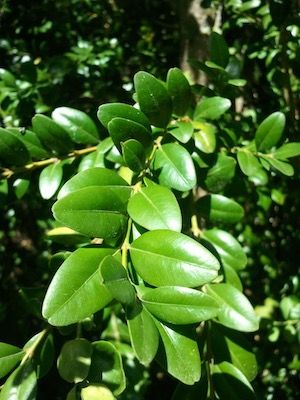BOX
I- Nomenclature
Latin name: Buxus sempervirens
Family : Buxaceae
Common names: Common Box, European box, Boxwood [i]
Etymology
From the Latin buxis, and the Greek pyxos "box tree"
II- Legends and traditions
Buxus became a symbol of immortality on account of its slow growth, great longevity and evergreen leaves.
The Greeks and Romans made writing tablets from box wood.
On Palm Sunday, Christians place blessed box twigs near a crucifix.
III- Botanical description
Description: A family of shrubs and small trees that grow very slowly (around 10 cm/year) and can live for centuries.
The leaves are opposite, tough, oval or lanceolate, dark green and shiny on the surface and yellowy green and matt on the underside. The stalk is very short.
In March-April, the plant produces sessile blooms in the auxiliary of the leaves. The flowers are yellowy-green with no corolla. The blooms consist of a number of male flowers and one female flower with 3 styles.
The fruit is a small capsule around 3 cm long, which opens in September to release its seeds.
Habitat: The box is native to western and southern Europe, southwest, southern and eastern Asia, Africa, Madagascar, northernmost South America, Central America, Mexico and the Caribbean, with the majority of species tropical or subtropical. Only the European and some Asian species are frost-tolerant.
Pars used : Leaves and bark
IV- Active ingredients
|
Leaves & bark |
|
Alkaloids Mucilage |
V- Therapeutic uses
Properties
|
Bark |
Leaves |
|
Depurative Antipyretic Induces sweating |
Purgative |
Indications
Internal use
Feverish conditions (malaria)
Bile duct infections
Biliary insufficiency
Rheumatism
Gout
Syphilis
Nervous disorders
Epilepsy
External use
Infected and slow-healing wounds
Dosage
Internal use
Infusion: 1 teat spoon of bark and leaves for each cup of water. Boil and infuse for 10 minutes. Take 2-3 cups daily (NB: box easily upsets the stomach)
Decoction:
40g of leaves and bark; boil for 10 minutes. Take 1-2 cups a day for arthritis.
60g of leaves and bark; boil for 10 minutes. Take 2 cups a day with lemon juice for gout affecting the feet.
50g of leaves and bark; boil for 10 minutes. Take 2 cups a day for rheumatism, sub acute articular rheumatism or for fevers.
External use
Rub: finely chop 50g of fresh leaves and macerate for 10 days in ½ liter of rum. Filter, add a few drops of lavender essential oil. Use daily as a rub for alopecia (accelerated hair loss). Also good for dandruff.
Wine: boil 250 g of wood chips in a liter of wine for 30 minutes then leave to cool. Use as a local rub for weak limbs.
Decoction: use a decoction of leaves as a wash for gangrenous wounds and ulcers.
VI- Precaution of use
Contraindication
Do not use during menstruation, if using contraception, during pregnancy or breast feeding.
Must be scrupulously dosed as buxus can become highly toxic, cause vomiting, convulsions and respiratory problems.
Not to be used for prolonged periods of time. Do not take for more than one week at a time and with a minimum of one week break before taking repeat use.



